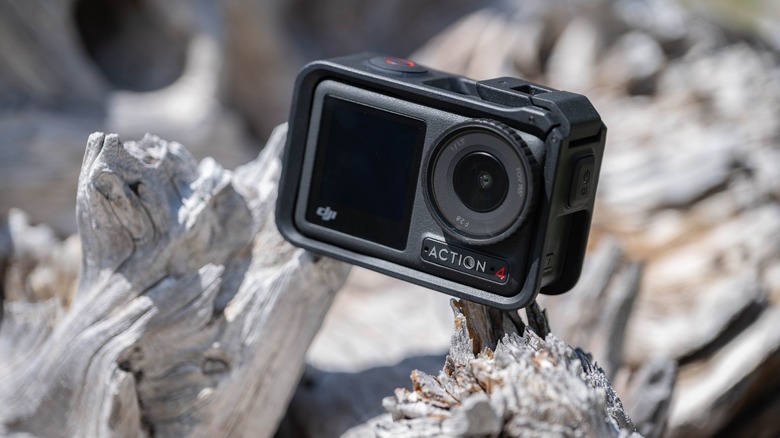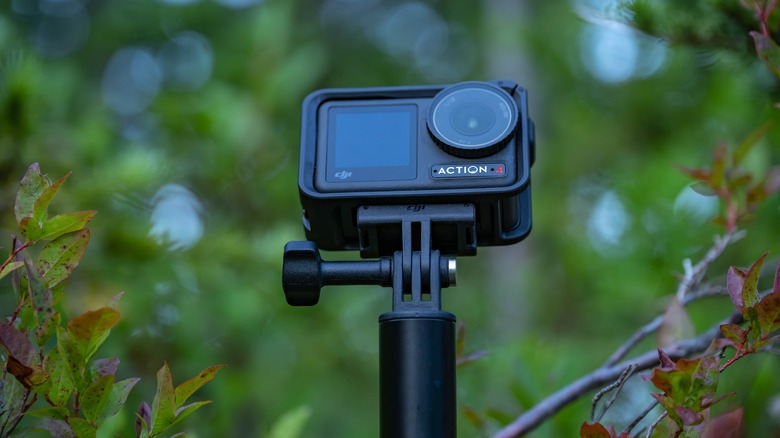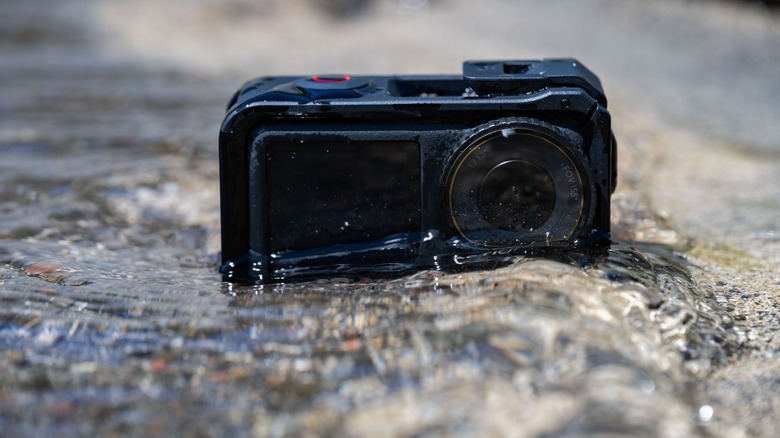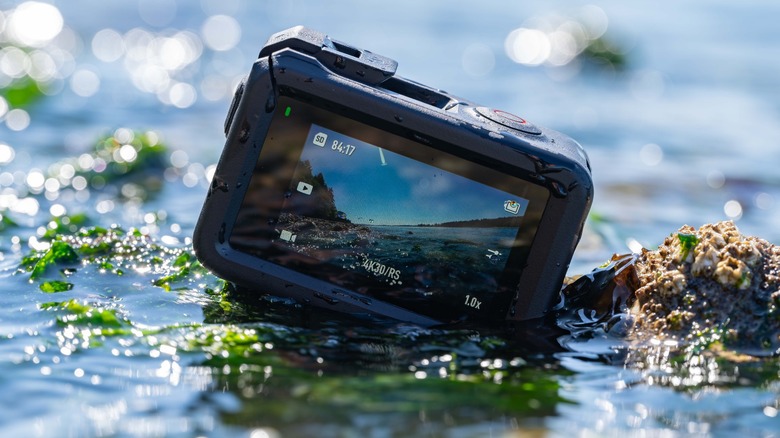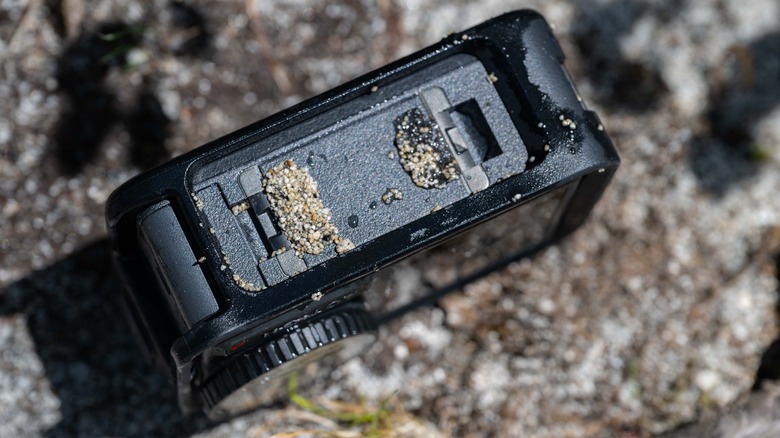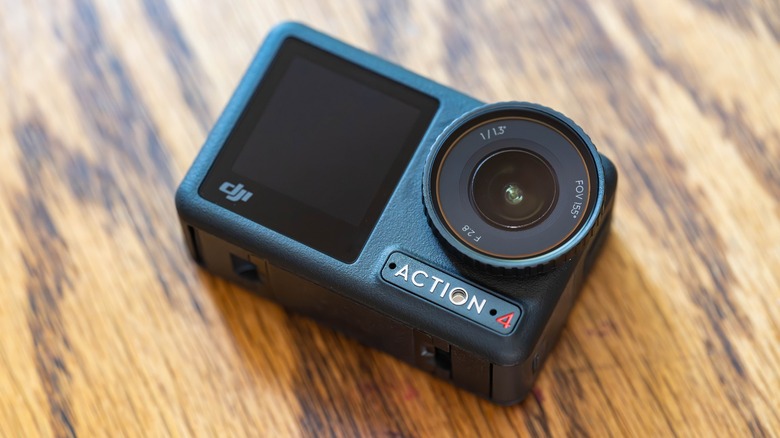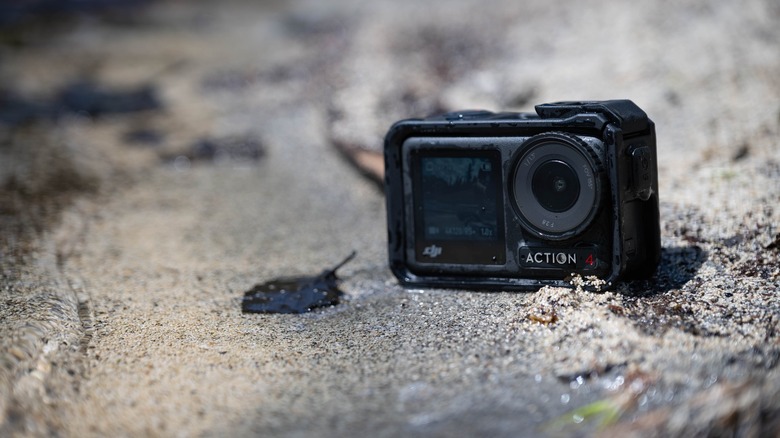DJI Osmo Action 4 Review: Raising The Bar Without Breaking The Mold
- Relatively large sensor
- Best low light performance in an action camera
- Extremely effective video stabilization
- Rugged and waterproof design
- Excellent range of optional accessories
- 10-bit D-log recording capability
- Rocksteady+ stabilization is remarkably effective
- Magnetic mount picks up dirt and is hard to clean
- Only an incremental update from the DJI Action 3
- No starlapse feature
- Somewhat pricey
The DJI Osmo Action 4 is the latest in DJI's now well-established line of action cameras, and it seems that after several years of bouncing around experimenting with wildly different designs, DJI has settled on a solid path forward for this line of products. There's no getting around the obvious inspiration taken from GoPro here, but perhaps this is just the ideal shape for an action camera to be. It's inside that rugged, waterproof shell where the key differences are to be found.
On paper, it's quick to see that the one key new feature of the Osmo Action 4 is its new, larger sensor, which DJI claims improves image quality, particularly in low light. If that difference is real and noticeable, that could catapult the Osmo Action 4 ahead of the competition, so we put it to the test in environments ranging from cold ocean waters to high-altitude hiking.
DJI provided a sample of the Osmo Action 4 to test and review.
A familiar design
You really have to put the Osmo Action 3 and the Osmo Action 4 next to each other in order to actually discern the differences between the two, and on the surface at least those differences are almost purely aesthetic. The Action 4 is a darker shade of gray and has a red ring on the video capture button. The interior lens elements are also noticeably larger, and the magnetic quick-release pad is now more smoothly textured.
The Action 4 is designed to be used inside of the included case, which must be removed to replace the battery or microSD card, though the USB-C port remains accessible with the case attached. A record button is located on the top, while the power and quick switch button is located on the side. As with the Action 3, the Action 4 features both front and rear touchscreens. It's a perfectly functional design, if rather unambitious compared to the unique and highly innovative DJI Action 2. The Action 3 is exactly what you'd expect when you think of an action camera in terms of appearance.
There are many accessories available for the Action 4, including those made for the Action 3. We tested it with the Osmo Action GPS Bluetooth Remote controller, Osmo Action Mini Extension Rod, and the Adventure Combo, which notably includes extra batteries inside of a handy battery charging case, all of which can be recommended.
One tough camera
We accidentally put the DJI Osmo Action 4's durability to the test a few times, most notably when it slipped from a camera bag and tumbled several feet onto the asphalt of a trailhead parking lot. Despite what was actually quite a hard hit, the Osmo Action 4 survived with only a few inconsequential scratches. It's a tough cookie to be sure, made even tougher by the included case, the open design of which helps prevent the camera's most vulnerable parts from impacting hard surfaces. This proved true both when the camera was dropped, as well as underwater while snorkeling, an activity which has resulted in all the other action cameras we've used gaining their fair share of battle damage.
Speaking of underwater photography, the Action 4 has improved waterproofing and is rated down to 18 meters. This is significantly better than other action cameras, and It can also operate down to -4, and up to 104 degrees Fahrenheit.
In terms of battery life, you're looking at 160 minutes of operating time, though that will depend on how you use the Osmo Action 4. We found its battery capacity to be roughly what we'd expect from a modern action camera.
Smooth video capture with Rocksteady+
While the DJI Osmo Action 4 inherits the same Rocksteady+ image stabilization from the Osmo Action 3, this isn't a slight against the Action 4. Footage looks great, even when walking or running in dim conditions, with the end result being slightly, but noticeably better than competing action cameras. Horizonsteady stabilization is also available if you want the camera to automatically keep your video level, and regular non-plus Rocksteady stabilization is also included as a less intense stabilizing option.
Timelapse recording and slow motion are also available. Timelapse footage looks great, though we wish it was possible to record timelapse videos in 10-bit D-log. The GoPro Hero 11 Black, on the other hand, allows access to a flat color profile and other options in timelapse mode. Slow Motion goes up to 240fps at 1080p, or 4K 120fps. This puts the Osmo Action 4 slightly behind the GoPro Hero 11 Black in this regard, as the Hero 11 Black can record at 240fps in 2.7k resolution.
We were disappointed to discover that the Osmo Action 4 does not include a star trails mode for astrophotography, something that has become standard in GoPro and Insta360 action cameras. It's a real pity, considering the much better overall low-light performance of the Action 4.
Big sensor means Improved image quality
Action cameras typically feature relatively small sensors, and that leads to image quality taking a major hit. These are cameras where the priorities lie in durability, waterproofing, low weight, small size, and image stabilization. Image quality is by necessity limited by the prioritization of those factors, and thus progress in this regard is generally slow and incremental. However, in the case of the DJI Osmo Action 4, increased sensor size is the main area of advancement over the Osmo Action 3, and it really shows when you compare footage side-by-side.
Video and photos very clearly have a more natural and less processed look compared to contemporary action cameras, and the Action 4 is particularly impressive in low light. Adding to this improved image quality is the inclusion of a 10-bit D-log color profile recording capability, which captures more information than other profiles for a significant degree of wiggle room, which is much appreciated in post-processing.
Slick software with unfortunate DRM
Onboard, the Osmo Action 4 includes a very usable interface, which with practice makes it easy to switch modes and change settings on the touchscreen. The companion Mimo app for Android and IOS is also well developed, though it comes with one irritating component, which is the necessity that you activate the Action 4 by pairing it to the app. While this is usually straightforward and easy to accomplish, and you'd expect to have to do so with a drone, it's somewhat irritating to have to activate an action camera. With that said, the Mimo app is a great tool for remotely controlling the Osmo Action 4 and downloading footage from the camera.
The other companion app, called LightCut, is a really powerful tool for mobile editing. It's designed to edit videos with the aid of an AI and to do so without having to download the footage from the camera. It's convenient, and overall the Action 4 is very strong in terms of its software; we just wish that the Mimo app was a nice optional extra rather than an artificial necessity.
ND filters and livestreaming
On a bright day in the mountains, Neutral Density (ND) filters can be an absolute boon to filmmakers trying to cut down on glare and achieve the ideal frame rate for cinematic video footage. The optional set of filters for the DJI Osmo Action 4 are high quality and easy to use. The kit includes ND8, ND16, and ND32 strength filters which offered a noticeable improvement to image quality when filming a high-contrast scene with shining clouds and white glacier-clad peaks reflecting the afternoon sun. Note that the filters do add a noticeable color cast to your photos and videos, though this can be corrected in post-processing.
The Osmo Action 4 also has competent live-streaming capabilities for sharing your adventures in real time. It features a stereo microphone array that delivers remarkably good audio quality, and the camera's excellent low-light performance makes it a viable choice for live streaming at home in dimly lit conditions. When streaming through your phone it connects via WiFi, and can easily be simultaneously charged with a USB power bank. Connecting it to a computer as a webcam is seamless and easy. We plugged it in via USB-C to a desktop PC and it worked immediately without hardly any setup at all.
The pros and cons of magnets
With the same magnetic locking system as the Osmo Action 3, the Action 4 inherits compatibility with Action 3 accessories. This system certainly has its advantages and disadvantages, though the Action 4 unfortunately has acquired a new flaw all its own here.
On the bottom of the camera is a magnetic plate with a groove on either side, onto which magnetic quick-release plates clip. This magnetic clip system is very solid, and it's much more quick and convenient to use than a traditional action camera mount.
However, every implementation of a magnetic clip system like this that we've tested has the disadvantage of accumulating magnetic particles of dirt and sand, which is difficult to clean and compromises the integrity of the system. Unfortunately with the Action 4 this problem has actually become slightly worse, as the magnetic plate now has a tendency to acquire scratches from sharp particles of sand, whereas the Action 3 had a more durable surface on the magnetic plate.
While these problems are unfortunate, and integral to a magnetic locking system, they aren't a deal breaker either. There are certainly times when the quick-release system caused us to reach for the Osmo Action 4 over other action cameras purely for the sake of convenience.
Stiff competition
Given the similarities between them, it's necessary to compare the DJI Osmo Action 4 against the GoPro Hero 11 Black. This was quite an even competition last year when comparing the Hero 11 against the Action 3, and the gap has closed still further with the Action 4. With the larger sensor in the Action 4 providing significantly better image quality, there is now a real incentive to choose it over the Hero 11. However, the Hero 11 has an excellent star trails mode, is superior when it comes to slow motion video capture, and its unique 8:7 format sensor which allows you to capture horizontal and vertical videos simultaneously is an advantage.
The Insta360 Go 3 is a very different sort of camera and offers its own unique advantages, most notably the minuscule size of its camera module. This makes up for its lower-resolution sensor and less impressive slow-motion capabilities. Insta360 also makes the One RS modular camera, which can be purchased with a variety of camera modules, including the 4K boost module that's comparable to the Action 4. Though it's certainly a step down from the Osmo Action 4 in some ways, It's also a much more flexible system, and its base price is much lower.
Which camera you pick is largely going to depend on what you're personally looking for in an action camera, though with that said, the excellent image quality of the Action 4 makes it highly compelling.
Sticker shock
Starting at $399, the DJI Osmo Action 4 is $70 more expensive than the Action 3, $20 more than the Insta360 Go 3, $150 more than the Insta360 One RS 4K Boost, and $75 more than the GoPro Hero 11 Black (Including the cost of a GoPro subscription and its included $100 discount). This puts the DJI Osmo Action 4 in the uncomfortable position of being somewhat pricier. To be fair, these aren't major price gaps, but with cameras that are so closely matched, small differences in price become more meaningful.
With that said, $399 is not a bad price, considering the capabilities of the Osmo Action 4, and its bigger sensor certainly justifies the extra expense. We tested the Osmo Action 4 Adventure Combo, which is priced at $499, and it's certainly worth it for all the included accessories. The optional Osmo Action GPS Bluetooth Remote Controller will set you back $79, while the Osmo Action Mini Extension Rod costs $49. Other accessories we did not test vary between $16 and $79.
Overall, the Osmo Action 4 isn't badly priced, but it isn't a bargain either.
Conclusion
Initially, we couldn't help but feel like the DJI Osmo Action 4 was just a rebadged Action 3 with a higher price tag. However, after comparing it with the Action 3 and other contemporary action cameras, the Action 4 comes with significant and very noticeable image quality gains. While there are certainly a number of very valid complaints to level against the Action 4, there's no action camera I'd rather have when recording in low light.
In some situations, the Osmo Action 4 is so markedly better than the competition in terms of sharpness and realistic natural colors that it will be an easy first choice for many people, and we can easily recommend it. However, its downsides are such that it's not quite the clear current leader in its genre, and which action camera you choose comes down to what features and capabilities you most value.
The bottom line is that we can easily recommend the Action 4 if you're in the market for a new rugged and waterproof camera to accompany you on your adventures.
